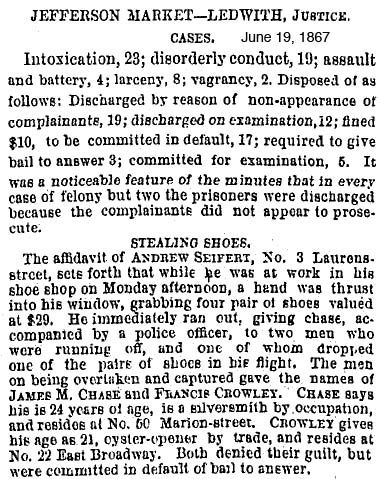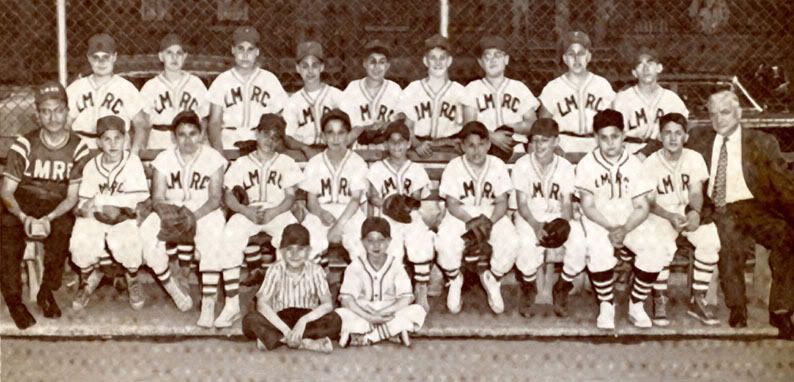Showing posts with label Ward 10. Show all posts
Showing posts with label Ward 10. Show all posts
Saturday, April 10, 2010
Sunday, April 4, 2010
24 Forsyth Street: 1910
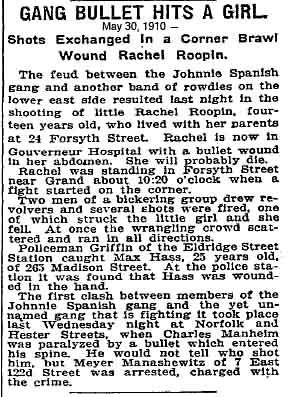
I tried to find out if Rachel survived. She's not in any census subsequent to this. It's possible she could have married. I'm sure the name is misspelled. Matthew Manashewitz was working as a chauffeur in the Bronx in 1930. In 1930 24 Forsyth was the home of the Shafran family. Bernice Shafran would marry Joe Kuperstein and move into Knickerbocker Village.
The Papered Wall Of Forsyth Street
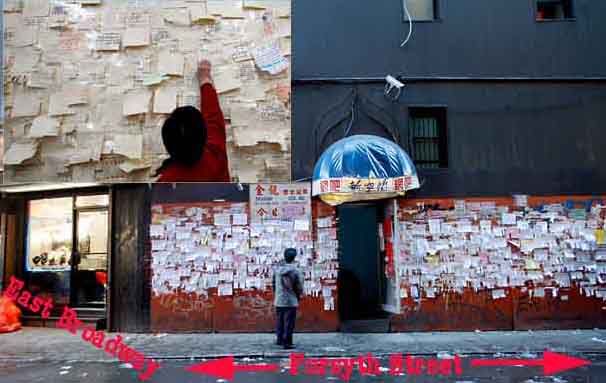
an excerpt from the nytimes
When a Papered Wall Acts Like a Web Site, By SARAH MASLIN NIR
MANY people hustle right past the wall pasted with paper fliers on Forsyth Street, in the shadow of the Manhattan Bridge. But others make pilgrimages to this easternmost reach of Chinatown, where scores of advertisements, most handwritten in Chinese, are posted, their phone-number strips curling like beckoning fingers.
The wall functions as an offline Craigslist — a Craigswall, if you will — where Mandarin and Cantonese speakers do brisk business renting rooms to longtime residents and newly arrived immigrants for whom English and the Internet are as yet unnavigable. There is a similar wall inside a grocery store in Flushing, Queens.
Though the wall on Forsyth Street advertises mostly apartments, Margaret Chin, who represents Chinatown on the City Council, said she had seen all kinds of fliers around the neighborhood, including complaints about particular lawyers.
“If you have something to say,” she said, “you write it up and you just post it up.” The custom of hawking goods and ideas by poster and placard took hold in China after the 1949 revolution, said Lincoln Cushing, co-author of “Chinese Revolutionary Posters: Art From the Great Proletarian Cultural Revolution.”
In rural towns, “You would have this wall that would be taken over” by placards, he said. “People stand in front of this wall and read this, and they respond by putting up their own character poster.” Flier-covered Chinatown, he said, is quite likely “an echo of that.”
Saturday, April 3, 2010
Joseph Cohen: 171 Ludlow Street
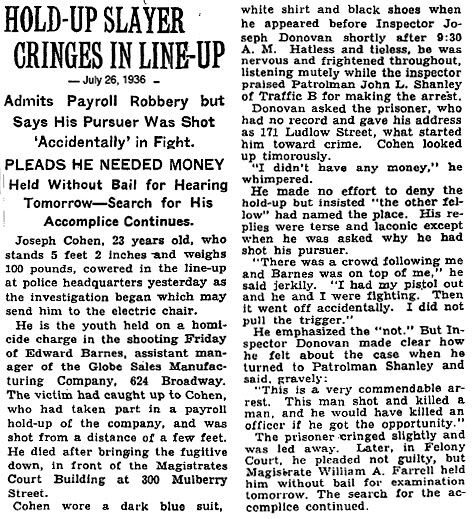
I wonder where Cohen was living at 171 Ludlow, unless it changed from a stable sometime between 1933 and 1936.
Tuesday, March 9, 2010
Division Street Speakeasy: 1932
Alcohol Poison 1932
by 1932, the East Broadway, 10th Ward area is no longer fancy. Many local residents were dying of alcohol poisoning.
by 1932, the East Broadway, 10th Ward area is no longer fancy. Many local residents were dying of alcohol poisoning.
East Broadway: 1895
East Broadway Linens 1895
by 1895, East Broadway was a fancy shopping destination
by 1895, East Broadway was a fancy shopping destination
Sunday, January 10, 2010
Division Street 1902
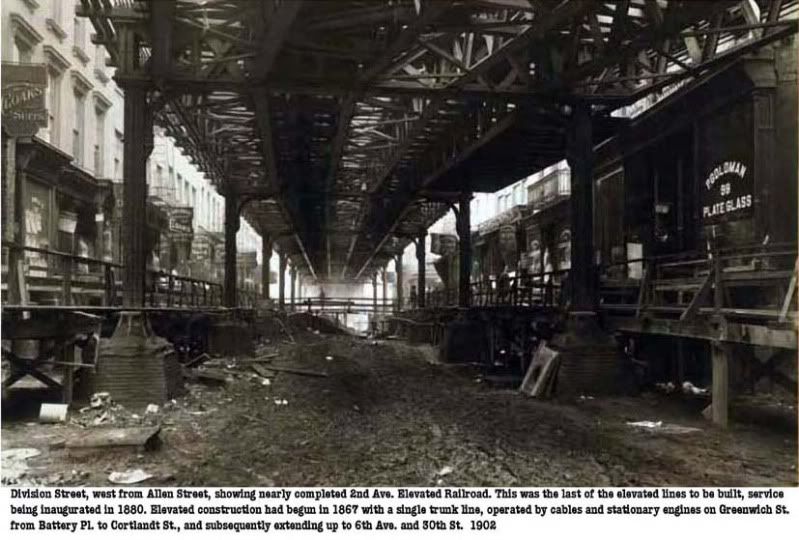
The right side of the block is the north side with even numbers. The first store on the right seems to be a glass store numbered 98. This is before the Manhattan Bridge is built. PS 124, the Yung Wing School, is located at 40 Division Street.
Tuesday, January 5, 2010
New Life For The Loew's Canal?
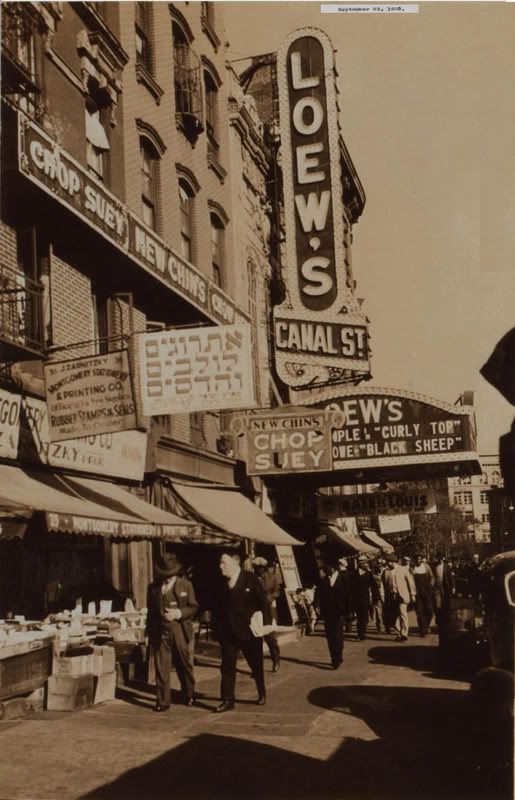
above, pictured in 1935
an excerpt from the villager
The long-shuttered Loew’s Canal Theater in Chinatown could get a new life as a performing arts center.
The proposal to fix up and reopen the 83-year-old theater is far from a done deal, but the space’s owner agreed last week to do a feasibility study.
“It would be the first theater opening in Chinatown in over a generation, probably several generations,” City Councilmember Alan Gerson said. “It’ll bolster the arts and culture of Chinatown and it will also bolster the economy.”
Gerson began fighting for a performing arts center for Chinatown after 9/11. Amid many disagreements over the future of the neighborhood and how revitalization money should be spent, a cultural center was one of the few ideas that garnered no opposition, recalled Amy Chin, president of the nonprofit leading the project’s planning.
“There’s no central gathering space, no place indoors for large-scale community events,” Chin said. “Virtually all cultural groups [in Chinatown] are operating out of spaces that are just decrepit.”
Progress on the performing arts center has been slow over the past eight years, in large part because it is difficult to find a large, available space in Chinatown. With the nonprofit CREATE in Chinatown (Committee to Revitalize and Enrich the Arts and Tomorrow’s Economy), Chin has looked into dozens of possibilities.
But no space is quite like the Loew’s Canal, at 31 Canal St. near Ludlow St. Designed by renowned theater architect Thomas Lamb, the 2,339-seat theater opened in 1926. Many of the original, ornate, terra-cotta details remain, although the seats were cleared out long ago when the theater was turned into a warehouse.
For about the last 25 years, the theater has been owned by Thomas Sung, founder of the Abacus Federal Savings Bank in Chinatown. CREATE started talking to Sung about the space three years ago and even sent Rogers Marvel Architects in to examine it.
But Sung initially had other ideas, hoping to rent the theater to a commercial tenant and build condos above. He filed plans to that effect with the city Department of Buildings during the summer, though they have not yet been approved, possibly because the city is looking to landmark the building.
But then, this week, Sung and CREATE released a joint statement saying they are committed to rebuilding the theater. In an interview Tuesday, Sung said a theater would be good for the community, especially because it would offer a central place to experience Chinese culture.
Sung said he is willing to give up the rent he could make from the ground-floor theater space, but only if he is able to use the building’s air rights to build 12 or 13 stories of condos on top. It is unclear how feasible it would be to build the condos, because they would have to be supported by the theater below, which is an open space with no columns. Sung is consulting with an engineer.
“We are very much dedicated to seeing this happen,” Sung said, “but there are always financial constraints and physical constraints.” On the chances of the theater being built, he said, “I hate to speculate.”
a prior posting with a 2006 story about Loew's Canal memories
Monday, December 14, 2009
Shawn Slevin: New Yorker Of The Week
If memory serve's me correctly Shawn is, or was, a Grand Street resident and the sister of former PS 177er Elaine Katz.
from ny1.com
The latest New Yorker of the Week is making a big splash with more than 400 kids and 47 volunteers. NY1's Rebecca Spitz filed the following report.
When Shawn Slevin says when she was five years old, she almost drowned. After being afraid of the water for four years, she was finally able to get back in the pool.
"There was a swimming program that started in my local community and my parents coaxed me back into the water, and I was competing within the first year," says Slevin.
After Slevin stopped competing when she was in college, she became a swim coach for teams around the city. Three years ago, she decided to start her own not-for-profit swim team called The Swim Strong Foundation.
"I really wanted an opportunity to bring the principles that I learned and developed over the years out to a broader community," says Slevin.
She instructs more than 400 students of all skill levels, and the older kids mentor the younger ones.
"I really like the way she uses the older students to help the younger students, because she really does that right from the very beginning," says parent Ellen Fee.
"Since she helped me a lot in swimming, I wanted to pay back the favor, and I love teaching," says Abby Nicolas, a former student and volunteer.
The program is run entirely by volunteers at two pools in Queens and one in Brooklyn. Twenty-seven students have full scholarships, while the other swimmers pay between $9 and $15 for an hour-long lesson. The money is used to pay for the pool time.
"We want it to be more accessible for our families who can’t afford that," says Slevin.
Last month, Slevin started a swim program in Far Rockaway, Queens. She says it's especially needed in that community after several drownings occurred over the summer.
"Drowning is the second-largest cause of death for kids, and African-American kids drown three times as more as any other demographic, and we really want to make a change to that," says Slevin.
Slevin says she wants to help others avoid the experience she had as a child.
"I would love this to be not only a national program but a global program, because drowning is an issue all over the world," she says.
So, for giving kids an opportunity to dive into the water with confidence, Shawn Slevin is the latest New Yorker of the Week.
For more information about the Swim Strong Foundation, call 1-646-269-7897 or visit www.theswimstrongfoundation.org.
Rivington Street
A 2004 view of mainly Rivington Street and surrounding area
Labels:
neighborhood tours,
rivington street,
Ward 10
Saturday, November 28, 2009
Turkish Night Club On Allen Street: 1942
Turkish Night Club 2
The descriptions:
The descriptions:
New York, New York. Turkish nightclub on Allen Street
Joe Levy, Jewish-Turkish-American owner of a nightclub on Allen Street
Turkish-American and his wife who own a nightclub on Allen Street. Their son is in the United States Army
Orchestra at a Turkish nightclub on Allen Street
Orchestra in a Turkish nightclub on Allen Street. The girl plays a tambourine between dances.
Guests get up and dance to the Oriental music whenever they please
Habitues of a Turkish nightclub on Allen Street drinking beer and eating hors d'oeuvres. Apparently women are left at home
CREATED/PUBLISHED: 1942 Dec.
CREATOR:
Collins, Marjory, 1912-1985, photographer.
PART OF: Farm Security Administration - Office of War Information Photograph Collection (Library of Congress)
REPOSITORY: Library of Congress Prints and Photographs Division Washington, D.C. 20540 http://hdl.loc.gov/loc.pnp/pp.print
DIGITAL ID: (digital file from intermediary roll film) fsa 8d24224 http://hdl.loc.gov/loc.pnp/fsa.8d24224
Monday, November 16, 2009
The Great East River Shipyards Of The Past
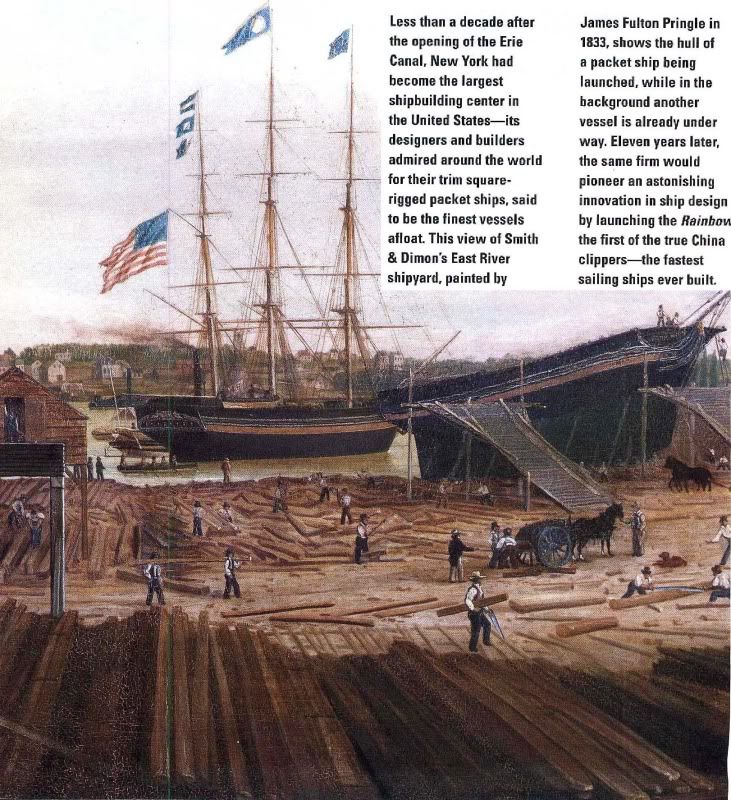
Fulton's steamboats were constructed nearby. I wonder if James Fulton Pringle was related. Here's a link to the full image
Robert Fulton: "The Forgotten Man Of The Hudson-Fulton-Champlain Quadricentennial Celebration"
Being curious about the man considered the forgotten man of the Hudson-Fulton-Champlain Quadricentennial celebration, I did some research on him. Quite an interesting guy. Hero or scoundrel? Sexual adventurer or opportunist? Audio from John Lienhard and KUHF-FM, Houston,
Kirkpatrick Sale's fascinating biography "The Fire of his Genius"
a review of Sale's book
Curriculum unit from ny state ed department
Hudson River Maritime Museum, an excellent source
Fulton's boats were built in the shipyards in Ward 10
His descendant, Yankee pitcher Cory Fulton Lidle!
Tuesday, November 3, 2009
Henry Eckstein: A LES Legend Passes

An email I received from Bernie Dolnansky
ECKSTEIN--Herbert, died peacefully at home in Great Neck at the age of 87 on October 27, 2009. Beloved husband of Nadine for 56 years; devoted father of Kenneth, Linda and Myra Mogilner; cherished father-in-law of Ruthann Eckstein and Dr. Alon Mogilner; adored grandfather of Max, Sam, Shoshana, Josh, Zack, Joey and Gabi; much loved brother of David, Eugene and Barbara Shostak. During his lifetime he was proprietor of H. Eckstein & Sons, a dry goods store and Lower East Side institution. He will be sorely missed.
I believe that's Eckstein's store window showing on Grand Street on the left of the picture above. I fondly recall my trips to Eckstein's with my mother. The basement at Eckstein's was a world unto itself and there was always interesting back and forth sales talk/flirting going on between my mother and the salesmen.
An excerpt from a 2004 nytimes article about Eckstein's
Trendiness Among the Tenements; Descendants Return to a Remade Lower East Side
By JOSEPH BERGER
H. Eckstein & Sons was not quite as much a fixture of the Lower East Side as Guss's Pickles or Yonah Schimmel Knish Bakery. Still, Brenda Zimmer spent much of her life there, haggling with customers in the cramped and hectic clothing store on Orchard Street that her family owned, hanging on until a greatly weakened Eckstein's finally shut its doors in 1998.
Yet when she told friends a few years ago that her daughter, Amy, was moving into one of the neighborhood's storied tenements, ''they looked a little shocked,'' she said.
''Everybody spent their lives trying to get out of there, and my daughter is trying to come back,'' Mrs. Zimmer said, recalling her friends' puzzlement and suggesting more than a little of her own.
The rapid changes in a neighborhood famous as the squalid foothold for immigrants just off the boat have produced more than a few such expressions of astonishment.
There are still many people around who were glad to escape the neighborhood when the old life seemed to be seeping out of it more than a half-century ago. Some of them are now wonderstruck as their adventurous children and grandchildren are returning.
On a recent stroll from Hester Street to Houston Street with Amy, Mrs. Zimmer seemed tickled that her daughter, a 28-year-old Yale graduate and freelance writer, had actually settled a few blocks from where Amy's grandfather was born and where Mrs. Zimmer worked full time for 15 years. Sure, only a handful of the wholesale and retail stores that sold hosiery, linens, lingerie, and handbags were still around, and even many of the bodegas of a more recent era of migration were gone. But the neighborhood had once again quickened to life, something closer to the bustle of the days when the walk-up tenements were teeming and the dowdy stores drew shoppers from all over for their Sunday bargains.
''Now it's exciting; it's prestigious to live there,'' Mrs. Zimmer, a high-spirited woman, observed.
Dry-goods shops are being replaced by restaurants with $30 entrees; by boutiques where the tastefully spaced wares are fashionably retro but the prices are decidedly nouveau; by galleries like Fusion-Arts Museum, which exhibits a robotlike ''fusion golem'' made of motorized hardware; by cafes where young people peck at laptops while sipping lattes; and even by one shop, Toys in Babeland, that, to Mrs. Zimmer's embarrassed amusement, sells sex toys.
''A very unusual store,'' Mrs. Zimmer observed, gathering up her dignity. ''Colorful.''
A link to another article by Amy Zimmer about Eckstein's
Friday, October 30, 2009
The Max Hochstim Association, AKA The Essex Market Court Gang
Eastman Smith Engel
much from the pdf above comes from the Rise and Fall of the Jewish Gangster in America by Albert Fried
Hochstin, along with Tammany boss Martin Engel, had saloons/houses of prostitution at 102, 121, and 123 Allen Streets and 33 Madison Street.
much from the pdf above comes from the Rise and Fall of the Jewish Gangster in America by Albert Fried
Hochstin, along with Tammany boss Martin Engel, had saloons/houses of prostitution at 102, 121, and 123 Allen Streets and 33 Madison Street.
Charles "Silver Dollar Smith" Solomon
Silver Dollar Smith
from wikipedia's entry on historical criminals of New York
There's more about Charles "Silver Dollar Smith" Solomon and his association with Monk Eastman over at the Lower East Side History Project
an excerpt
from wikipedia's entry on historical criminals of New York
1843-1899 Tammany Hall political organizer known as "Silver Dollar Smith". Solomon was the political boss of the old Tenth Ward district and owner of the Silver Dollar Saloon in Essex Street across the street from Market Street Court.
There's more about Charles "Silver Dollar Smith" Solomon and his association with Monk Eastman over at the Lower East Side History Project
an excerpt
Smith's saloon was one of the sites of operation for the Eastman Gang, run by Jewish gang leader Monk Eastman, who worked as a bouncer for Silver Dollar Smith. Smith himself was a corrupt local politician and member of the Max Hochstim Association, also known as the Essex Market Court Gang due to the saloon’s proximity to the Essex Market Court. The Silver Dollar Saloon was notorious for housing Tammany Hall leaders, politicians and false witnesses, and Smith was reported to physically threaten local saloon owners in the neighborhood. In one such instance, Smith was arrested for stabbing August Gloistein, owner of a saloon on 354 Grand Street.
"Halloween" 1901: A Scary LES Dude Of The Past: Monk Eastman
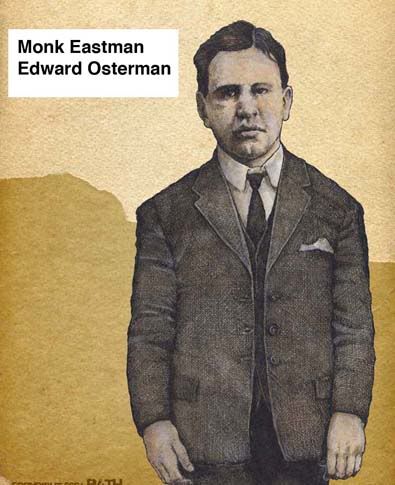
You wouldn't want to mess with Monk. Image by Pat Hamou. Pat has a great mobster site six for five and he sells his art work, very reasonably, on etsy

There's another story about Monk and the Silver Dollar Hotel/Saloon over at the Lower East Side History Project
Monk Eastman, aka: Joseph Morris, William Delaney, Edward Delaney, etc., was born around 1873 in Brooklyn under the name of Edward Osterman. His parents were respectable Jewish restaurateurs and set Edward up with a pet store on Penn street, near their restaurant. Edward grew bored and soon abandoned his store for the excitement of street life, gangsters, prostitutes, stuss games and all of the ilk associated with it. However, Monk (Edward) always held an extreme fondness for cats and birds and he later opened up a pet store on Broome street. Monk trained a pigeon to sit on his shoulder while he went about his street travels and sometimes carried a cat with him. This "sensitive" trait contrasted sharply with his fondness for backjacking assignments and other violent deeds. Monk boasted that he had never struck a women with his club or killed one. When a lady suffered a severe lapse in manners, he blackened her eyes.
"I only give her a little poke, just enough to put a shanty on her glimmer. But I always takes off me knucks first."
Around 1895, Monk moved to lower Manhattan and established himself as Sheriff of New Irving Hall. The "Sheriffs" acted as armed bouncers and were responsible for keeping order (of sorts) in the social clubs or resorts that were frequented and owned by gangsters/politicians. Monk developed a patois of clipped, slangy speech and an indifferent dress style. The artist's rendition of Monk shows him at his best, usually only when he was before a magistrate. Monk became very popular with the hoodlums of the East Side and they began to imitate his slang and sloppy clothes. Monk's outfit usually consisted of a derby hat several sizes too small, a blackjack tucked into his pants, open shirt, and brass knuckles adorning each hand. He carried a large club and enjoyed using it, "sending so many men to Bellevue Hospital's accident ward that ambulance drivers referred to it as the Eastman Pavilion."
After a few years, Monk quit his position as Sheriff of New Irving and moved up the crime ladder towards gang leader. Monk had established his kingdom by 1900 with more than twelve hundred warriors under the Eastman banner. The Eastman headquarters was a dive on Chrystie street, near the bowery, where they stockpiled slung-shots, revolvers, blackjacks, brass knuckles, and other tools of gang warfare. Their main sources of income were derived from houses of prostitution, stuss games (a form of faro), political engagements, blackjacking services, and the operations of pickpockets, footpads, and loft burglars. Tammany Hall, the political power in New York City, frequently engaged the services of Eastman to bring in the votes at election time. In return, Tammany Hall lawyers bailed Eastman out whenever he got arrested.
Monk Eastman's feud with Paul Kelly began over a strip of territory between Mike Salter's dive on Pell street and the Bowery. Eastman claimed domain over the territory from Monroe to Fourteenth streets and from the Bowery to the East River. Paul Kelly and his Five Pointers believed that their kingdom included the Bowery and any spoils found in this area. Eventually, the constant feuding would cause the downfall of both Monk Eastman and Paul Kelly.
Saturday, October 24, 2009
They Got Caught With Their Watch On
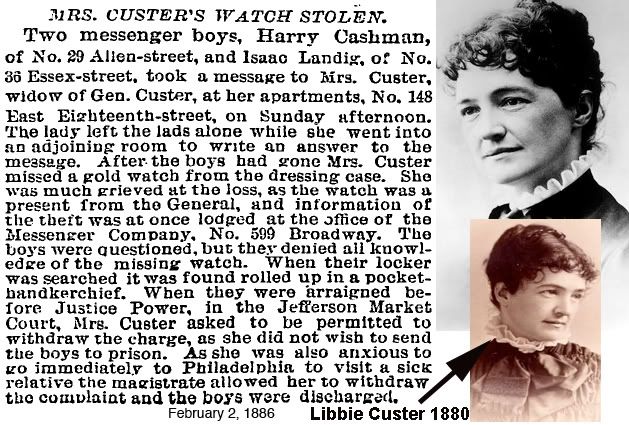
from Civil War Women
...After Custer's death, Libbie moved to New York, where she sought work to supplement her small widow's pension. She wrote three books about their life at frontier posts in order to ensure that Custer's memory would always be honored. In Boots and Saddles: Life in Dakota with General Custer, published in 1885, she describes her life from 1873 to 1876, and compellingly presents the shared anxiety of wives left at Fort Lincoln while their husbands fought and died at Little Big Horn.
In Tenting on the Plains: General Custer in Kansas and Texas (1887), she describes her experiences following General Custer in Kansas and Texas from 1865 to 1867. Insects, illness, and scorpions dominate her recollections of the march to Texas, and her Kansas memories include prairie fire, flood, and cholera.
In 1890, Libbie published her last book, Following the Guidon, in which she picks up the story when her husband returned to duty in Kansas in 1868 to join the campaign culminating in the Battle of Washita. She vividly recalls her fearful visits with captured Native Americans and tribal peace council delegates, while glorifying her husband's honest treatment of those he helped defeat.
Throughout her 57 years of widowhood, Mrs. Custer worked untiringly to defend her husband's reputation and transform him into a hero. She influenced a number of writers, and in all her works, her husband emerged as an exemplary son, brother, husband, and conscientious commanding officer. Since the army and the public saw Libbie as a model wife and a devoted widow, many Custer critics withheld their comments during her lifetime.
Known throughout her life for her undying devotion to her husband, Libbie was the only officer's wife to live in a tent on the edges of a Civil War battlefield, ride in the ranks with the soldiers, and accompany the 7th Cavalry on many of its expeditions. During those adventures, she wore her own uniformed dresses to show her dedication to her husband and the US Army.
Libbie Bacon Custer remained utterly devoted to her husband and never remarried. She died at her home in New York City on April 4, 1933, a few days before her 91st birthday. She was buried at West Point Military Academy next to her husband. They had no children.
Thursday, October 22, 2009
Pike Street Loop Project
From Bowery Boogie from October 12
An industrial sized robotic arm has recently taken up residency in the pedestrian island on Pike Street between Division and East Broadway. Code named “R-O-B,” the high-tech human-operated machine is part of the Pike Loop installation sponsored by the Storefront for Art and Architecture. We stopped by yesterday to scope the progress, and there’s already a wavy brick wall in the works. It was hard to avoid the spectacle and watch as the arm played a complex game of Jenga. Passersby were all equally amazed, with F-bombs of confusion dropped somewhat regularly.
I dropped an F-bomb myself. More great "city art" ala the Bloomberg Waterfalls from this past summer.
Subscribe to:
Posts (Atom)

